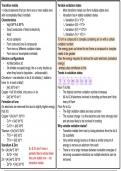Summary
Summary - Unit 15 - Transition Metals (9CHo)
- Course
- Institution
A summary of topic 15, organised so the notes are easy to understand. The notes are on slides, so they can be printed out and used as revision cards or posters, for revision on the go. The notes cross-reference the specification so it is easy to see where each bit of information has come from. They...
[Show more]



